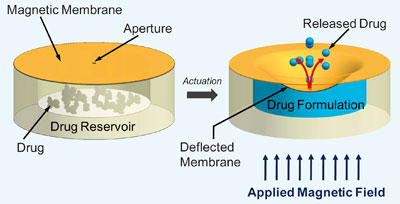 Another LOC article has been highlighted in Chemistry World! This article from Mu Chiao and colleagues describes the fabrication of a device that could be implanted behind the eye to release drugs on demand to treat retinal damage caused by diabetes.
Another LOC article has been highlighted in Chemistry World! This article from Mu Chiao and colleagues describes the fabrication of a device that could be implanted behind the eye to release drugs on demand to treat retinal damage caused by diabetes.
Diabetic retinopathy can lead to blindness. A current treatment is laser therapy, which is destructive and results in side effects, such as diminished side and night vision, and unwanted laser burns. Another therapy is to administer antiproliferative drugs, such as docetaxel (normally a cancer drug), but the compounds clear from the blood quickly, so high doses are needed to produce the desired effect, which increases toxicity to other tissues.
Mu Chiao and colleagues from the University of British Columbia in Vancouver have made a device to be implanted behind the eye that releases drugs when triggered by an external magnet. This means that the device doesn’t need a battery and lower doses can be used. Implantable devices have been made before but drug release is done by diffusion and the release rates can’t be controlled, which is a problem if the dosage rate needs to be adjusted when a patient’s condition changes.
To find out more read Elinor Richard’s Chemistry World article or download the article itself here:
On-demand controlled release of docetaxel from a battery-less MEMS drug delivery device
Fatemeh Nazly Pirmoradi, John K. Jackson, Helen M. Burt and Mu Chiao
Lab Chip, 2011, Advance Article
DOI: 10.1039/C1LC20134D










